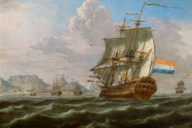By James Livingston
Back when New York Magazine asked me (and 52 other historians) what President Obama’s foreign policy legacy might be, I suggested that in the short term, the pivot toward Iran, away from Israel, was much more significant than the so-called pivot to Asia. In the long term, though, each move is part of a broader geopolitical vision invented at the dawn of the 20th century.
Let me explain. US foreign policy is now oriented to the reality on the ground, as they say, in the Middle East. The reality is that Iran has been the most significant and reliable American ally in the region since 2001, that it will continue to be so, and that, as the most modern and cosmopolitan of states between Europe and Asia—yes, more so than Israel—it should function as such.
The impending agreement on Iran’s nuclear capacity codifies that reality, which is as old as it is new. Think Persia, the Silk Road, then fast forward to the Shanghai Cooperation Organization (founded 2001 by Russia and China to develop east-west energy transport infrastructure, in which Iran is an “official observer” rather than a full member as long it remains under UN-endorsed sanctions), and the Iran-Pakistan-India pipeline agreement (initialed 2008).
Israel’s leaders understand this history and this horizon, and have been behaving accordingly—for years, they’ve been trying, and failing, to destroy Hezbollah, an Iranian client stationed in Lebanon and Gaza, with military equipment supplied by the US. Now they want to scuttle the impending international agreement on Iranian nuclear capacity because it will make Iran rather than Israel the “indispensable nation” in the Middle East.
Saudi Arabia’s rulers understand their impending demotion in the region as well as Israel’s leaders do, which is why they took it upon themselves to bomb Yemen—a farcical reprise of Israel’s attack on Lebanon in 2006—in the name of anti-terrorism, and why their head of state recently cancelled meetings with Obama, as if Benjamin Netanyahu’s infantile behavior is the new normal of diplomatic protocol.
The key here, in the Middle East, is China, which has invested hundreds of billions of dollars in Iran’s energy sector since 2008, as a hedge against both Russia and Saudi Arabia. Which is to say that the key here is oil, or rather energy, petroleum and natural gas. If you can reconfigure the production and distribution of these essential products in the Middle East, you make a Trans-Pacific Partnership plausible, and manageable. The invasion of Iraq was the military means to this end; acknowledgement of its failure leads back to Tehran.
Between them, Iran and Russia control 20% of the world’s oil reserves and 50% of the natural gas reserves. How to secure a Eurasian pipeline—that’s going to happen regardless of what the US says or does—which doesn’t install Russia as the middleman? This is the question for US policymakers. Making Iran an ally is the answer. Demoting Israel and Saudi Arabia are the collateral damage. (Domestically speaking, the collateral damage is fracking, which gives the US crucial bargaining power vis a vis both Iran and Russia.)
Iran has repeatedly demonstrated its willingness to be that ally, recently in the Syrian debacle, but no more intelligently and heroically than during the so-called surge in Iraq, in the fourth year of the American invasion. You remember that moment, when more than 50 US soldiers and Marines were dying every month at the hands of Shi’ite militias in Baghdad and Sunni insurgents in Anbar Province—both factions used recognizably terrorist tactics, including ethnic cleansing and suicide bombers—and when “national reconciliation” by means of political compromise between the Muslim sects was still a joke?
Iran was already contributing financial resources to the reconstruction of Iraq’s battered infrastructure, as it did through Hezbollah in Lebanon after the Israeli bombings of 2006. More important, it was already quelling every kind of violence in Baghdad proper.
Am I suggesting that Iran was the key player in the so-called surge? Read on.
The rapid recession of sectarian insurgency couldn’t have been the result of a bulked-up military presence in Baghdad, or in Anbar. According to the US military’s new Counterinsurgency Field Manual, published in 2007 by the University of Chicago Press, and prepared under the direction of David Petraeus (rhymes with betray us), an effective counterinsurgent force requires at least 20 combatants per 1,000 members of the local population.
By this calculation, 120,000 troops would have been required in Baghdad alone, a city of 6 million inhabitants, and another 10,000 in Anbar. The US sent 30,000 troops total. (Iraqi forces couldn’t have made up the difference because they were, then as now, too few and too divided against themselves.)
What happened? Why did the so-called surge “succeed”? Of course US military commanders bribed the Sunni tribal leaders and former Baathists of Anbar, who in turn disarmed their former allies from al-Qaeda in Mesopotamia.
But the real reason is this: the most formidable militia in Baghdad, the Mahdi Army led by the radical Shi’ite cleric Moktada al-Sadr, practically disappeared from the streets when the force that trained it—Iran’s Revolutionary Guard—ordered it to stand down.
In short: the “success” of the so-called surge was Iran’s doing.
OK, you might now ask, how are the brand-new pivot to Iran and the slow-motion pivot to Asia related? They’re indissoluble when viewed through the geopolitical lens ground by the founding fathers of 20th century American diplomacy, ca. 1898-1917.
Briefly, here’s what they saw through this lens:
(1) The history of civilizations was a history of empires, but the purpose of empire could no longer be conquest and exploitation; instead, its design was development, or modernization via transfers of technology (“direct investment”).
(2) The seat of empire had passed from east to west in the course of that history, and would continue to do so, even after the US had inherited this mantle from the UK: a multilateral world was already in the making, so China would someday be a world power.
(3) War had been both cause and effect of the passage of the seat of empire, but now, as world war and its consequences—rebellion, revolution, reaction—became unaffordable, the question had to be, how to prevent such cataclysm, how to preclude or postpone military solutions to diplomatic problems?
(4) Modern war, like modern civilization, was a function of trade war, competition between nations over access to economic resources; world peace could therefore be secured only by increasing the volume of world income, thus preempting any nation’s need to increase its share at the expense of all others; so conceived, anti-colonial imperialism, which would dismantle exclusive spheres of influence and make the free flow of finished goods and capital the global norm, was the only way to prevent world war and its consequences, thus permitting the passage, or rather the proliferation, of the seat of empire.
(5) Whoever controls or guides the nexus of Europe and Asia will be the seat of empire, but the resurrection of the Napoleonic dream of continental empire in the form of Mitteleuropa, or Lebensraum, is a recipe for disaster on a world scale: the resources of the Eurasian land mass must be shared among all countries, all nations, all peoples, because only this will permit the necessary increase in the volume of world income.
This geopolitical vision still prevails in policy-making circles, regardless of what Republicans and ardent Zionists keep saying about Israel’s role in the region. The BDS movement is, if you will, the vernacular expression of that vision—a way of saying that Israel is no less an outlaw state than Iran, no less deserving of sanctions, and that, in any case, the US cannot be the sole seat of empire in a world that includes the Peoples’ Republic of China.
In a nutshell (Harry Truman called the Marshall Plan and NATO “two halves of the same walnut”), that is how the Trans-Pacific Partnership and the impending international accord with Iran go together. You can’t have one without the other.
My purpose here is explanation, not approval, of the pivot to Iran and the TPP. Whether we like it or not, this is how foreign policy-makers think. Once upon a time, I was pretty sure that they got it right—that anti-colonial imperialism was the best available alternative to its vicious predecessors. I now believe that their attempts to manage the passage (or the dispersal) of the seat of empire have become desperate, and, more important, destructive of democracy. This new belief of mine surprises me.
For it puts me in the unlikely position of endorsing the arguments of Noam Chomsky and other radical critics of the impending trade agreement. I’m not claiming that the TPP is a “job killer,” as if full employment will be created by tariff walls and new spheres of influence. I don’t give a shit about that dimension of the debate because it’s as pointless as arguments against NAFTA in these terms: those “good jobs” in automobile manufacturing are never coming back.
No, I’m claiming, or rather, suggesting, that this empire is over. I never thought I’d say that.
***
James Livingston is Professor of History at Rutgers-New Brunswick and the editor of P/L. His last book was Against Thrift (2011); his new book, Fuck Work, will be out soon from UNC Press. He writes songs and sings them as a member of Moral Hazard.






No Comments